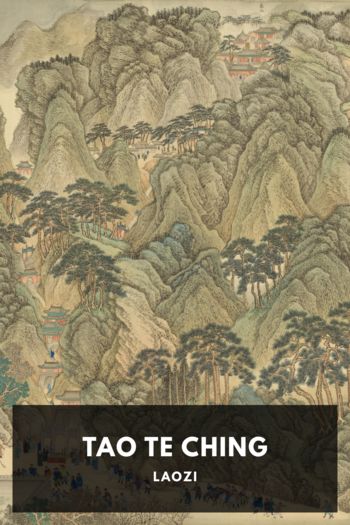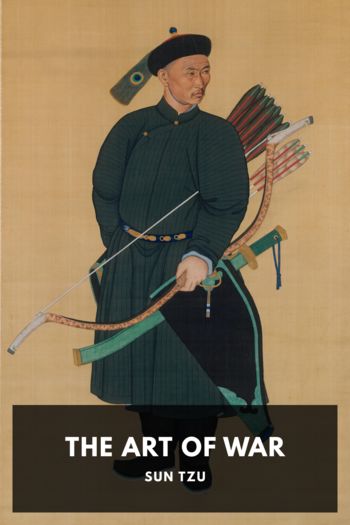Tao Te Ching by Laozi (reading comprehension books txt) 📕

- Author: Laozi
Book online «Tao Te Ching by Laozi (reading comprehension books txt) 📕». Author Laozi
後己, “Putting one’s self Last.” The subject is the power of the Tao, by its display of humility in attracting men. The subject and the way in which it is illustrated are frequent themes in the Ching. See chapters 8, 22, 39, 42, 61, et al.
The last sentence of par. 3 is found also in ch. 22. There seem to be no quotations from the chapter in Han Fei or Huai-nan; but Wu Chʽêng quotes passages from Tung Chung-shu (of the second century BC), and Yang Hsiung (BC 53–AD 18), which seem to show that the phraseology of it was familiar to them. The former says:—“When one places himself in his qualities below others, his person is above them; when he places them behind those of others, his person is before them;” the other, “Men exalt him who humbles himself below them; and give the precedence to him who puts himself behind them.” ↩
三寶, “The Three Precious Things.” This title is taken from par. 2, and suggests to us how the early framer of these titles intended to express by them the subject-matter of their several chapters. The three things are the three distinguishing qualities of the possessor of the Tao, the three great moral qualities appearing in its followers, the qualities, we may venture to say, of the Tao itself. The same phrase is now the common designation of Buddhism in China—the Tri-ratna or Ratna-traya, “the Precious Buddha,” “the Precious Law,” and “the Precious Priesthood (or rather Monkhood) or Church;” appearing also in the “Tri-śaraṇa,” or “formula of the Three Refuges,” what Dr. Eitel calls “the most primitive formula fidei of the early Buddhists, introduced before Southern and Northern Buddhism separated.” I will not introduce the question of whether Buddhism borrowed this designation of Taoism, after its entrance into China. It is in Buddhism the formula of a peculiar church or religion; in Taoism a rule for the character, or the conduct which the Tao demands from all mean. “My Tao” in par. 1 is the reading of Wang Pi; Ho-shang Kung’s text is simply 我. Wang Pi’s reading is now generally adopted.
The concluding sentiment of the chapter is equivalent to the saying of Mencius (VII ii iv 2), “If the ruler of a state love benevolence, he will have no enemy under heaven.” “Heaven” is equivalent to “the Tao,” the course of events—Providence, as we should say. ↩
配天, “Matching Heaven.” The chapter describes the work of the practiser of the Tao as accomplished like that of Heaven, without striving or crying. He appears under the figure of a mailed warrior (士) of the ancient chariot. The chapter is a sequel of the preceding, and is joined on to it by Wu Chʽêng, as is also the next. ↩
玄用, “The Use of the Mysterious (Tao).” Such seems to be the meaning of the title. The chapter teaches that, if war were carried on, or rather avoided, according to the Tao, the result would be success. Laozi’s own statements appear as so many paradoxes. They are examples of the procedure of the Tao by “contraries,” or opposites.
We do not know who the master of the military art referred to was. Perhaps the author only adopted the style of quotation to express his own sentiments. ↩
知難, “The Difficulty of being (rightly) Known.” The Tao comprehends and rules all Laozi’s teachings, as the members of a clan were all in the loins of their first father (宗), and continue to look up to him; and the people of a state are all under the direction of their ruler; yet the philosopher had to complain of not being known. Laozi’s principle and rule or ruler was the Tao. His utterance here is very important. Compare the words of Confucius in the Analects, XIV ch. 37, et al.
Par. 2 is twice quoted by Huai-nan, though his text is not quite the same in both cases. ↩
知病, “The Disease of Knowing.” Here, again, we have the Tao working “by contraries,”—in the matter of knowledge. Compare par. 1 with Confucius’s account of what knowledge is in the Analects, II ch. 17. The par. 1 is found in one place in Huai-nan, lengthened out by the addition of particles; but the variation is unimportant. In another place, however, he seems to have had the correct text before him.
Par. 2 in Han Fei also lengthened out, but with an important variation (不病 for 病病), and I cannot construe his text. His 不 is probably a transcriber’s error. ↩
愛己, “Loving one’s Self.” This title is taken from the expression in par. 4; and the object of the chapter seems to be to show how such loving should be manifested, and to enforce the lesson by the example of the “sage,” the true master of the Tao.
In par. 1 “the great dread” is death, and the things which ought to be feared and maybe





Comments (0)